CISCO Case Study: Business Environment in Telecommunications Retail
VerifiedAdded on 2023/04/20
|18
|4464
|157
Report
AI Summary
This report provides an analysis of CISCO's business approach within the telecommunications retail sector. It explores the company's market position, competitive landscape, and future prospects in the telecommunications industry. The report highlights the differences between telecommunications infrastructure and service provisioning, detailing CISCO's specific offerings and business strategies related to commercial dimensions and market forces. It also discusses key features of the telecommunications retail industry compared to other service sectors, analyzing the current business environment including network accessibility issues, competition, and trends in business partnerships, mergers, and acquisitions. Additionally, the report touches upon the development of mobile and wireless communication technologies and CISCO's billing structure.

Running head: TELECOMMUNICATIONS BUSINESS ENVIRONMENT
Telecommunications Business Environment
Name of the student:
Name of the university:
Author note:
Telecommunications Business Environment
Name of the student:
Name of the university:
Author note:
Paraphrase This Document
Need a fresh take? Get an instant paraphrase of this document with our AI Paraphraser
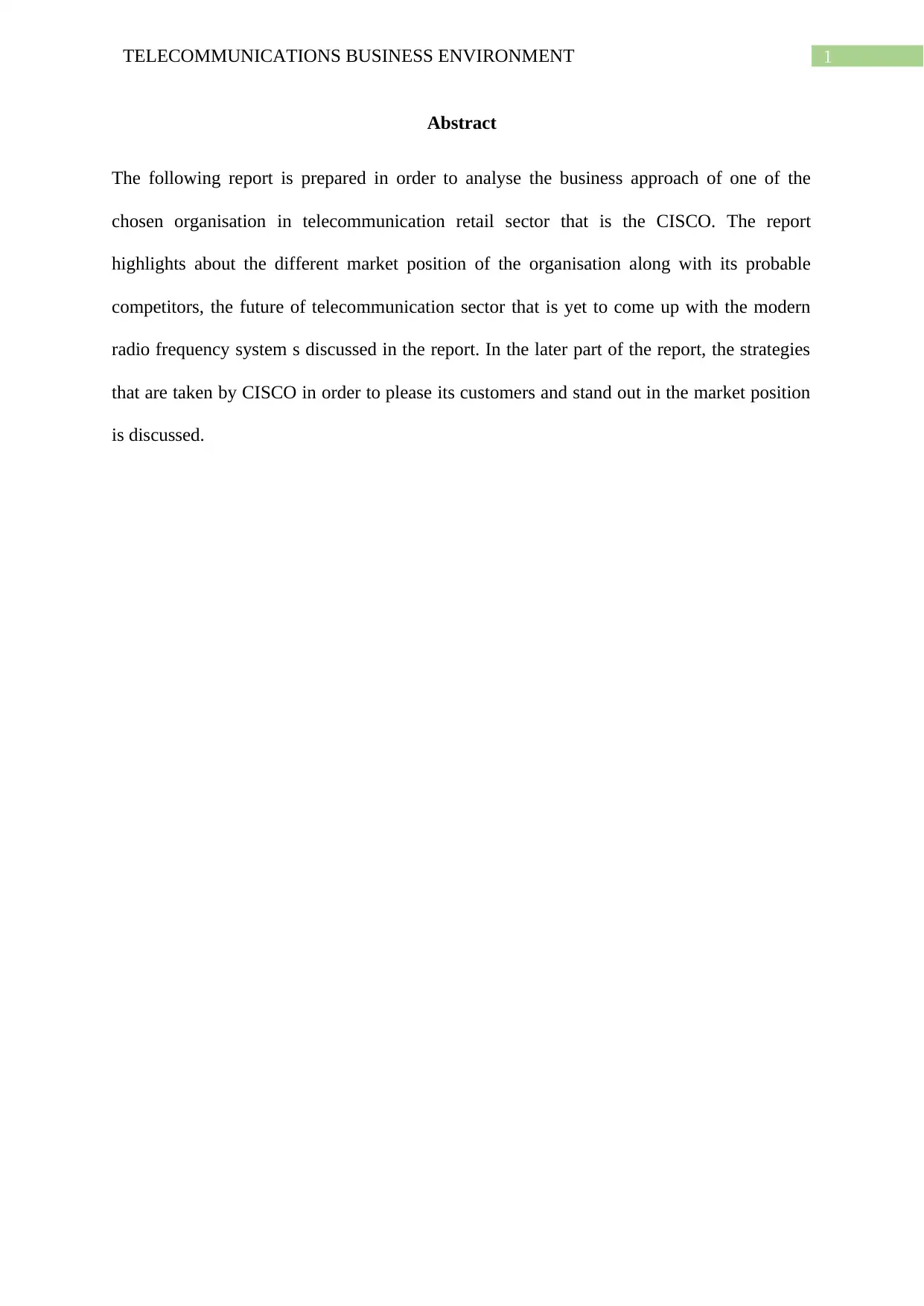
1TELECOMMUNICATIONS BUSINESS ENVIRONMENT
Abstract
The following report is prepared in order to analyse the business approach of one of the
chosen organisation in telecommunication retail sector that is the CISCO. The report
highlights about the different market position of the organisation along with its probable
competitors, the future of telecommunication sector that is yet to come up with the modern
radio frequency system s discussed in the report. In the later part of the report, the strategies
that are taken by CISCO in order to please its customers and stand out in the market position
is discussed.
Abstract
The following report is prepared in order to analyse the business approach of one of the
chosen organisation in telecommunication retail sector that is the CISCO. The report
highlights about the different market position of the organisation along with its probable
competitors, the future of telecommunication sector that is yet to come up with the modern
radio frequency system s discussed in the report. In the later part of the report, the strategies
that are taken by CISCO in order to please its customers and stand out in the market position
is discussed.
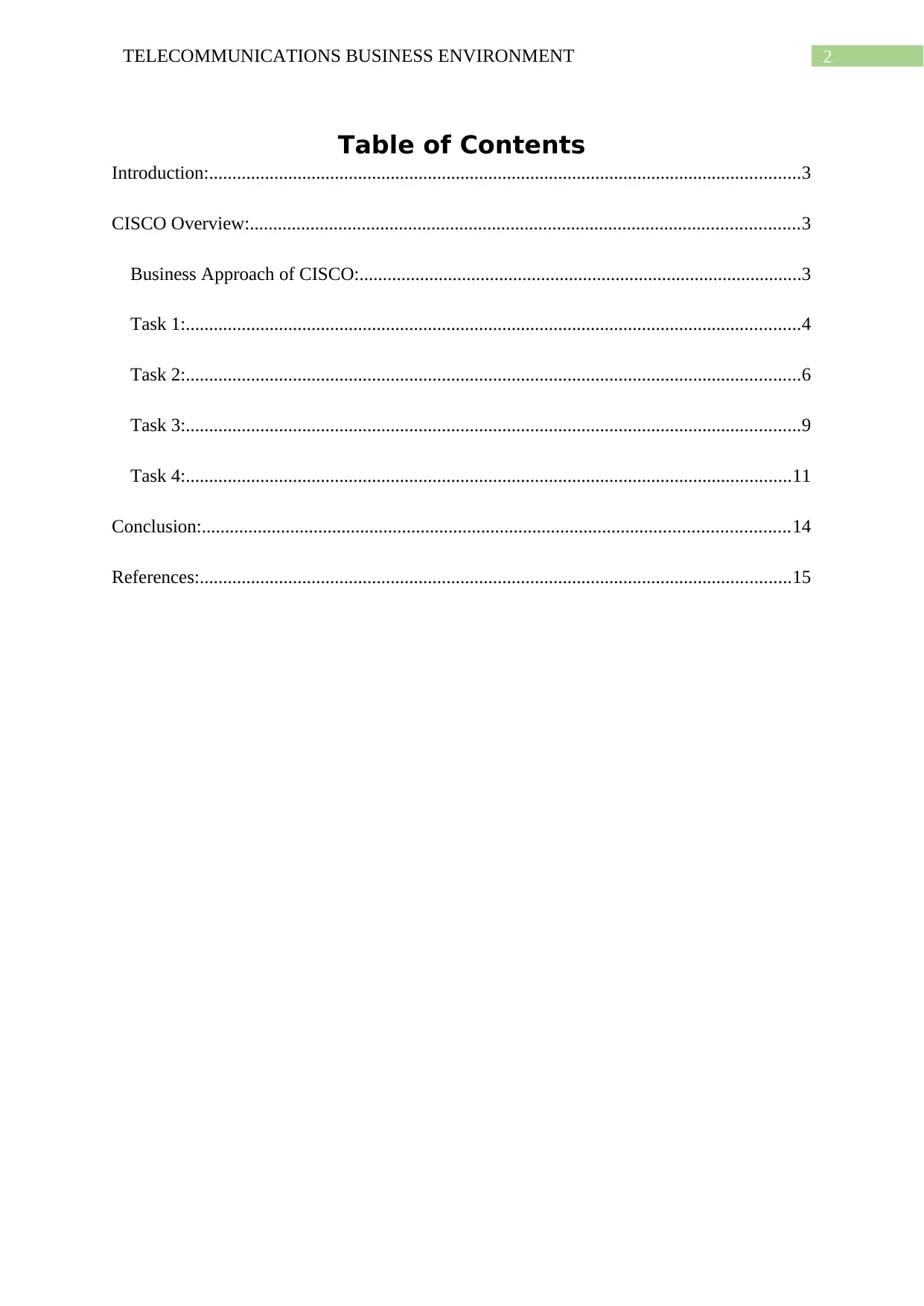
2TELECOMMUNICATIONS BUSINESS ENVIRONMENT
Table of Contents
Introduction:...............................................................................................................................3
CISCO Overview:......................................................................................................................3
Business Approach of CISCO:...............................................................................................3
Task 1:....................................................................................................................................4
Task 2:....................................................................................................................................6
Task 3:....................................................................................................................................9
Task 4:..................................................................................................................................11
Conclusion:..............................................................................................................................14
References:...............................................................................................................................15
Table of Contents
Introduction:...............................................................................................................................3
CISCO Overview:......................................................................................................................3
Business Approach of CISCO:...............................................................................................3
Task 1:....................................................................................................................................4
Task 2:....................................................................................................................................6
Task 3:....................................................................................................................................9
Task 4:..................................................................................................................................11
Conclusion:..............................................................................................................................14
References:...............................................................................................................................15
⊘ This is a preview!⊘
Do you want full access?
Subscribe today to unlock all pages.

Trusted by 1+ million students worldwide
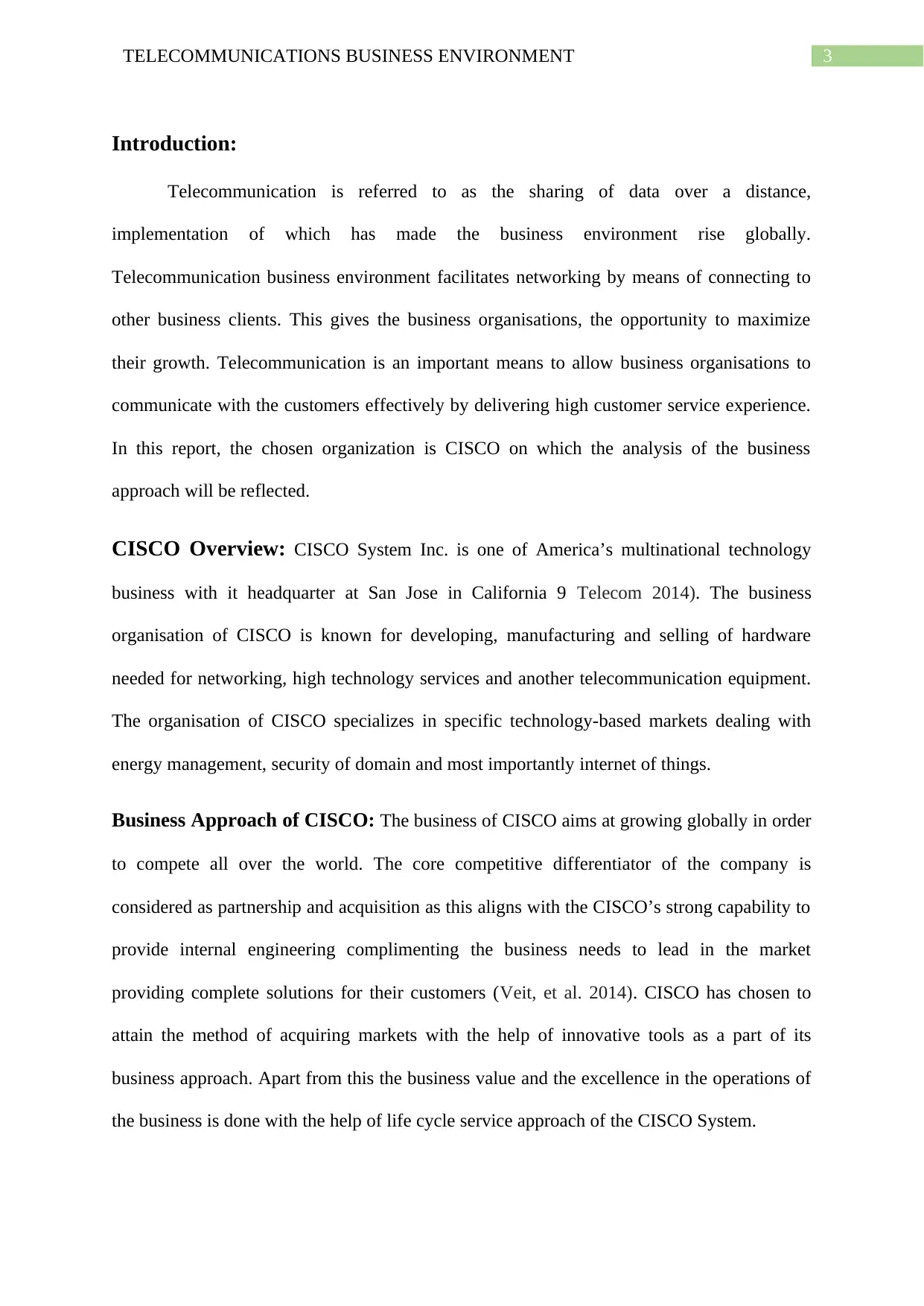
3TELECOMMUNICATIONS BUSINESS ENVIRONMENT
Introduction:
Telecommunication is referred to as the sharing of data over a distance,
implementation of which has made the business environment rise globally.
Telecommunication business environment facilitates networking by means of connecting to
other business clients. This gives the business organisations, the opportunity to maximize
their growth. Telecommunication is an important means to allow business organisations to
communicate with the customers effectively by delivering high customer service experience.
In this report, the chosen organization is CISCO on which the analysis of the business
approach will be reflected.
CISCO Overview: CISCO System Inc. is one of America’s multinational technology
business with it headquarter at San Jose in California 9 Telecom 2014). The business
organisation of CISCO is known for developing, manufacturing and selling of hardware
needed for networking, high technology services and another telecommunication equipment.
The organisation of CISCO specializes in specific technology-based markets dealing with
energy management, security of domain and most importantly internet of things.
Business Approach of CISCO: The business of CISCO aims at growing globally in order
to compete all over the world. The core competitive differentiator of the company is
considered as partnership and acquisition as this aligns with the CISCO’s strong capability to
provide internal engineering complimenting the business needs to lead in the market
providing complete solutions for their customers (Veit, et al. 2014). CISCO has chosen to
attain the method of acquiring markets with the help of innovative tools as a part of its
business approach. Apart from this the business value and the excellence in the operations of
the business is done with the help of life cycle service approach of the CISCO System.
Introduction:
Telecommunication is referred to as the sharing of data over a distance,
implementation of which has made the business environment rise globally.
Telecommunication business environment facilitates networking by means of connecting to
other business clients. This gives the business organisations, the opportunity to maximize
their growth. Telecommunication is an important means to allow business organisations to
communicate with the customers effectively by delivering high customer service experience.
In this report, the chosen organization is CISCO on which the analysis of the business
approach will be reflected.
CISCO Overview: CISCO System Inc. is one of America’s multinational technology
business with it headquarter at San Jose in California 9 Telecom 2014). The business
organisation of CISCO is known for developing, manufacturing and selling of hardware
needed for networking, high technology services and another telecommunication equipment.
The organisation of CISCO specializes in specific technology-based markets dealing with
energy management, security of domain and most importantly internet of things.
Business Approach of CISCO: The business of CISCO aims at growing globally in order
to compete all over the world. The core competitive differentiator of the company is
considered as partnership and acquisition as this aligns with the CISCO’s strong capability to
provide internal engineering complimenting the business needs to lead in the market
providing complete solutions for their customers (Veit, et al. 2014). CISCO has chosen to
attain the method of acquiring markets with the help of innovative tools as a part of its
business approach. Apart from this the business value and the excellence in the operations of
the business is done with the help of life cycle service approach of the CISCO System.
Paraphrase This Document
Need a fresh take? Get an instant paraphrase of this document with our AI Paraphraser
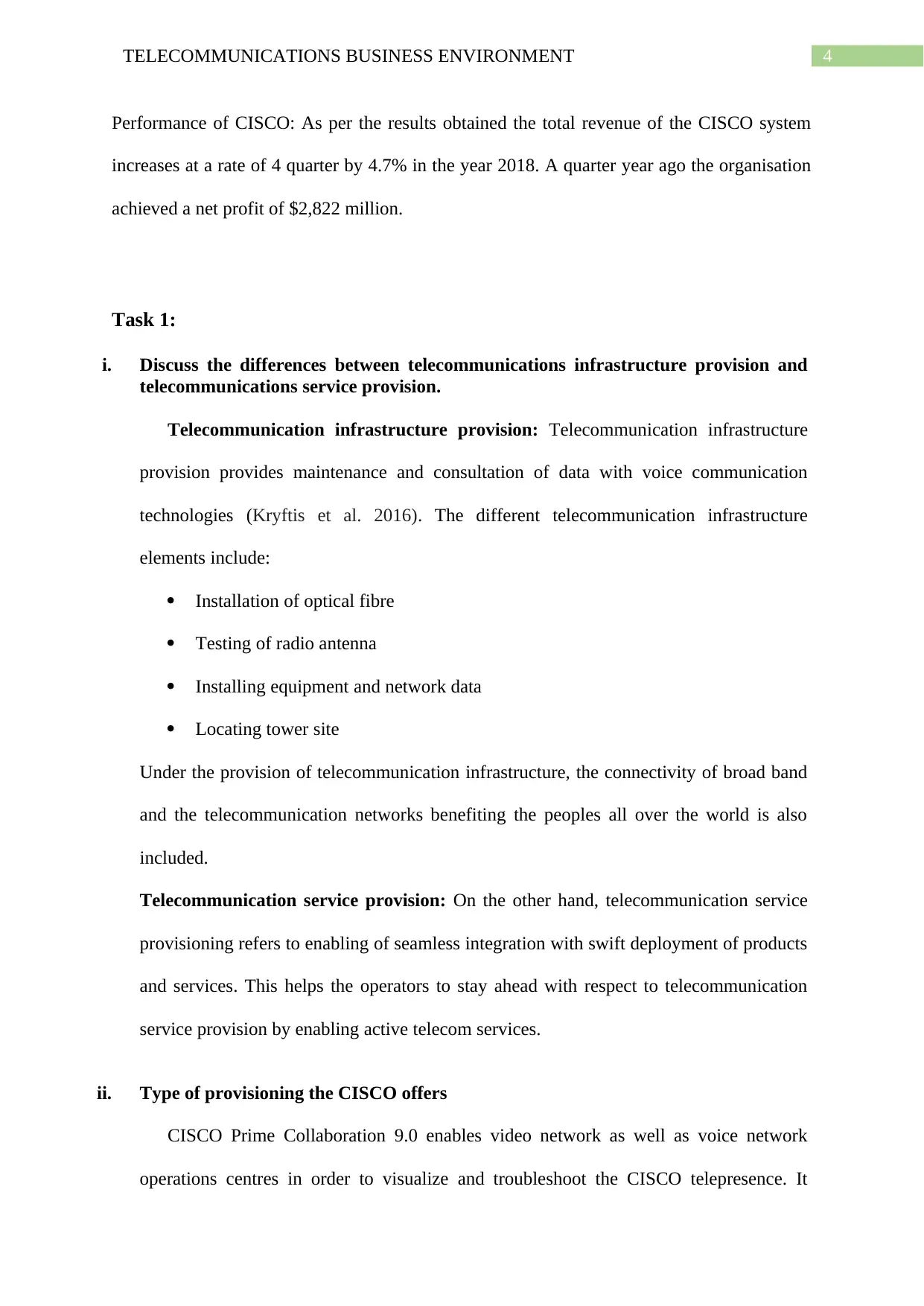
4TELECOMMUNICATIONS BUSINESS ENVIRONMENT
Performance of CISCO: As per the results obtained the total revenue of the CISCO system
increases at a rate of 4 quarter by 4.7% in the year 2018. A quarter year ago the organisation
achieved a net profit of $2,822 million.
Task 1:
i. Discuss the differences between telecommunications infrastructure provision and
telecommunications service provision.
Telecommunication infrastructure provision: Telecommunication infrastructure
provision provides maintenance and consultation of data with voice communication
technologies (Kryftis et al. 2016). The different telecommunication infrastructure
elements include:
Installation of optical fibre
Testing of radio antenna
Installing equipment and network data
Locating tower site
Under the provision of telecommunication infrastructure, the connectivity of broad band
and the telecommunication networks benefiting the peoples all over the world is also
included.
Telecommunication service provision: On the other hand, telecommunication service
provisioning refers to enabling of seamless integration with swift deployment of products
and services. This helps the operators to stay ahead with respect to telecommunication
service provision by enabling active telecom services.
ii. Type of provisioning the CISCO offers
CISCO Prime Collaboration 9.0 enables video network as well as voice network
operations centres in order to visualize and troubleshoot the CISCO telepresence. It
Performance of CISCO: As per the results obtained the total revenue of the CISCO system
increases at a rate of 4 quarter by 4.7% in the year 2018. A quarter year ago the organisation
achieved a net profit of $2,822 million.
Task 1:
i. Discuss the differences between telecommunications infrastructure provision and
telecommunications service provision.
Telecommunication infrastructure provision: Telecommunication infrastructure
provision provides maintenance and consultation of data with voice communication
technologies (Kryftis et al. 2016). The different telecommunication infrastructure
elements include:
Installation of optical fibre
Testing of radio antenna
Installing equipment and network data
Locating tower site
Under the provision of telecommunication infrastructure, the connectivity of broad band
and the telecommunication networks benefiting the peoples all over the world is also
included.
Telecommunication service provision: On the other hand, telecommunication service
provisioning refers to enabling of seamless integration with swift deployment of products
and services. This helps the operators to stay ahead with respect to telecommunication
service provision by enabling active telecom services.
ii. Type of provisioning the CISCO offers
CISCO Prime Collaboration 9.0 enables video network as well as voice network
operations centres in order to visualize and troubleshoot the CISCO telepresence. It
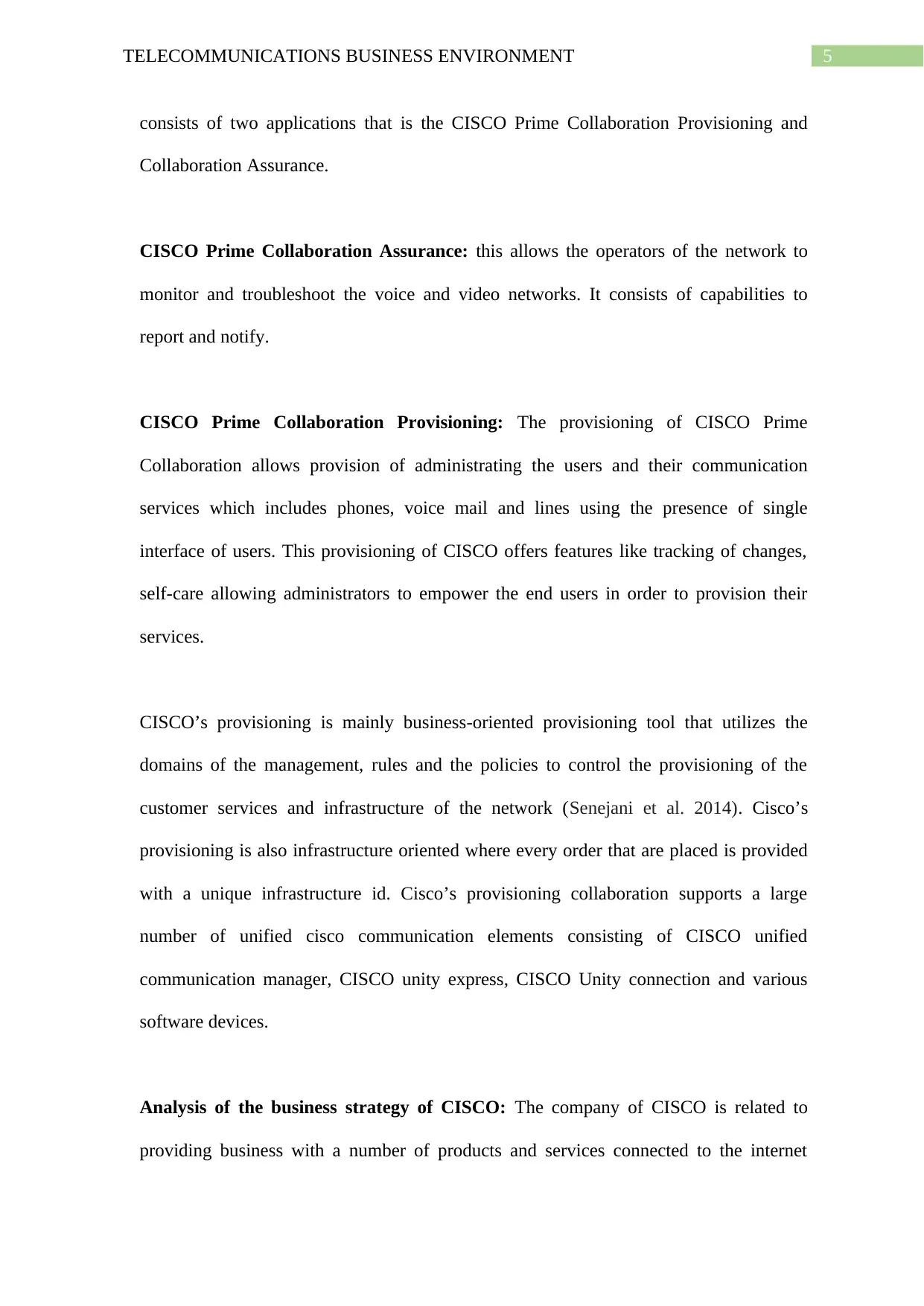
5TELECOMMUNICATIONS BUSINESS ENVIRONMENT
consists of two applications that is the CISCO Prime Collaboration Provisioning and
Collaboration Assurance.
CISCO Prime Collaboration Assurance: this allows the operators of the network to
monitor and troubleshoot the voice and video networks. It consists of capabilities to
report and notify.
CISCO Prime Collaboration Provisioning: The provisioning of CISCO Prime
Collaboration allows provision of administrating the users and their communication
services which includes phones, voice mail and lines using the presence of single
interface of users. This provisioning of CISCO offers features like tracking of changes,
self-care allowing administrators to empower the end users in order to provision their
services.
CISCO’s provisioning is mainly business-oriented provisioning tool that utilizes the
domains of the management, rules and the policies to control the provisioning of the
customer services and infrastructure of the network (Senejani et al. 2014). Cisco’s
provisioning is also infrastructure oriented where every order that are placed is provided
with a unique infrastructure id. Cisco’s provisioning collaboration supports a large
number of unified cisco communication elements consisting of CISCO unified
communication manager, CISCO unity express, CISCO Unity connection and various
software devices.
Analysis of the business strategy of CISCO: The company of CISCO is related to
providing business with a number of products and services connected to the internet
consists of two applications that is the CISCO Prime Collaboration Provisioning and
Collaboration Assurance.
CISCO Prime Collaboration Assurance: this allows the operators of the network to
monitor and troubleshoot the voice and video networks. It consists of capabilities to
report and notify.
CISCO Prime Collaboration Provisioning: The provisioning of CISCO Prime
Collaboration allows provision of administrating the users and their communication
services which includes phones, voice mail and lines using the presence of single
interface of users. This provisioning of CISCO offers features like tracking of changes,
self-care allowing administrators to empower the end users in order to provision their
services.
CISCO’s provisioning is mainly business-oriented provisioning tool that utilizes the
domains of the management, rules and the policies to control the provisioning of the
customer services and infrastructure of the network (Senejani et al. 2014). Cisco’s
provisioning is also infrastructure oriented where every order that are placed is provided
with a unique infrastructure id. Cisco’s provisioning collaboration supports a large
number of unified cisco communication elements consisting of CISCO unified
communication manager, CISCO unity express, CISCO Unity connection and various
software devices.
Analysis of the business strategy of CISCO: The company of CISCO is related to
providing business with a number of products and services connected to the internet
⊘ This is a preview!⊘
Do you want full access?
Subscribe today to unlock all pages.

Trusted by 1+ million students worldwide
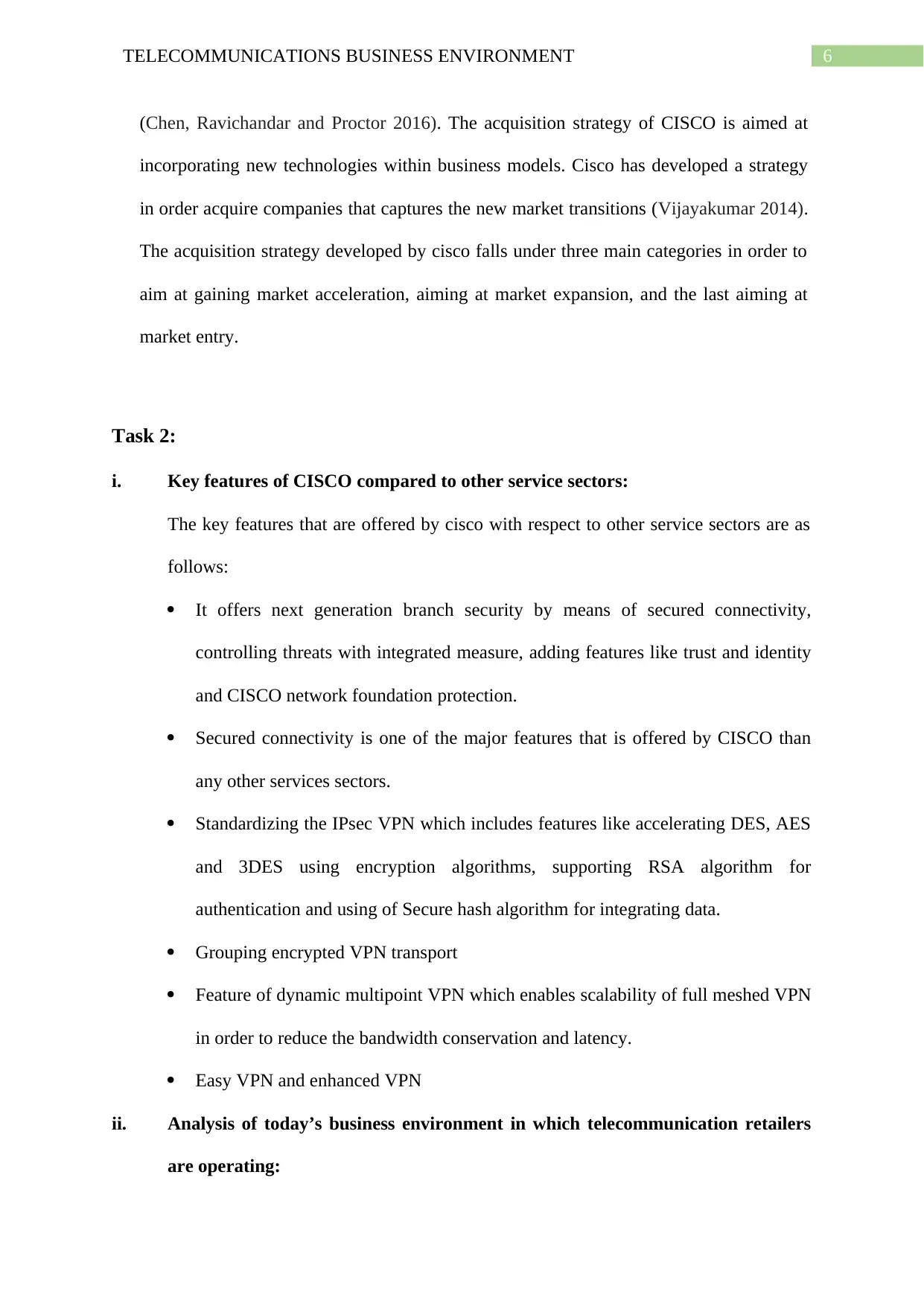
6TELECOMMUNICATIONS BUSINESS ENVIRONMENT
(Chen, Ravichandar and Proctor 2016). The acquisition strategy of CISCO is aimed at
incorporating new technologies within business models. Cisco has developed a strategy
in order acquire companies that captures the new market transitions (Vijayakumar 2014).
The acquisition strategy developed by cisco falls under three main categories in order to
aim at gaining market acceleration, aiming at market expansion, and the last aiming at
market entry.
Task 2:
i. Key features of CISCO compared to other service sectors:
The key features that are offered by cisco with respect to other service sectors are as
follows:
It offers next generation branch security by means of secured connectivity,
controlling threats with integrated measure, adding features like trust and identity
and CISCO network foundation protection.
Secured connectivity is one of the major features that is offered by CISCO than
any other services sectors.
Standardizing the IPsec VPN which includes features like accelerating DES, AES
and 3DES using encryption algorithms, supporting RSA algorithm for
authentication and using of Secure hash algorithm for integrating data.
Grouping encrypted VPN transport
Feature of dynamic multipoint VPN which enables scalability of full meshed VPN
in order to reduce the bandwidth conservation and latency.
Easy VPN and enhanced VPN
ii. Analysis of today’s business environment in which telecommunication retailers
are operating:
(Chen, Ravichandar and Proctor 2016). The acquisition strategy of CISCO is aimed at
incorporating new technologies within business models. Cisco has developed a strategy
in order acquire companies that captures the new market transitions (Vijayakumar 2014).
The acquisition strategy developed by cisco falls under three main categories in order to
aim at gaining market acceleration, aiming at market expansion, and the last aiming at
market entry.
Task 2:
i. Key features of CISCO compared to other service sectors:
The key features that are offered by cisco with respect to other service sectors are as
follows:
It offers next generation branch security by means of secured connectivity,
controlling threats with integrated measure, adding features like trust and identity
and CISCO network foundation protection.
Secured connectivity is one of the major features that is offered by CISCO than
any other services sectors.
Standardizing the IPsec VPN which includes features like accelerating DES, AES
and 3DES using encryption algorithms, supporting RSA algorithm for
authentication and using of Secure hash algorithm for integrating data.
Grouping encrypted VPN transport
Feature of dynamic multipoint VPN which enables scalability of full meshed VPN
in order to reduce the bandwidth conservation and latency.
Easy VPN and enhanced VPN
ii. Analysis of today’s business environment in which telecommunication retailers
are operating:
Paraphrase This Document
Need a fresh take? Get an instant paraphrase of this document with our AI Paraphraser
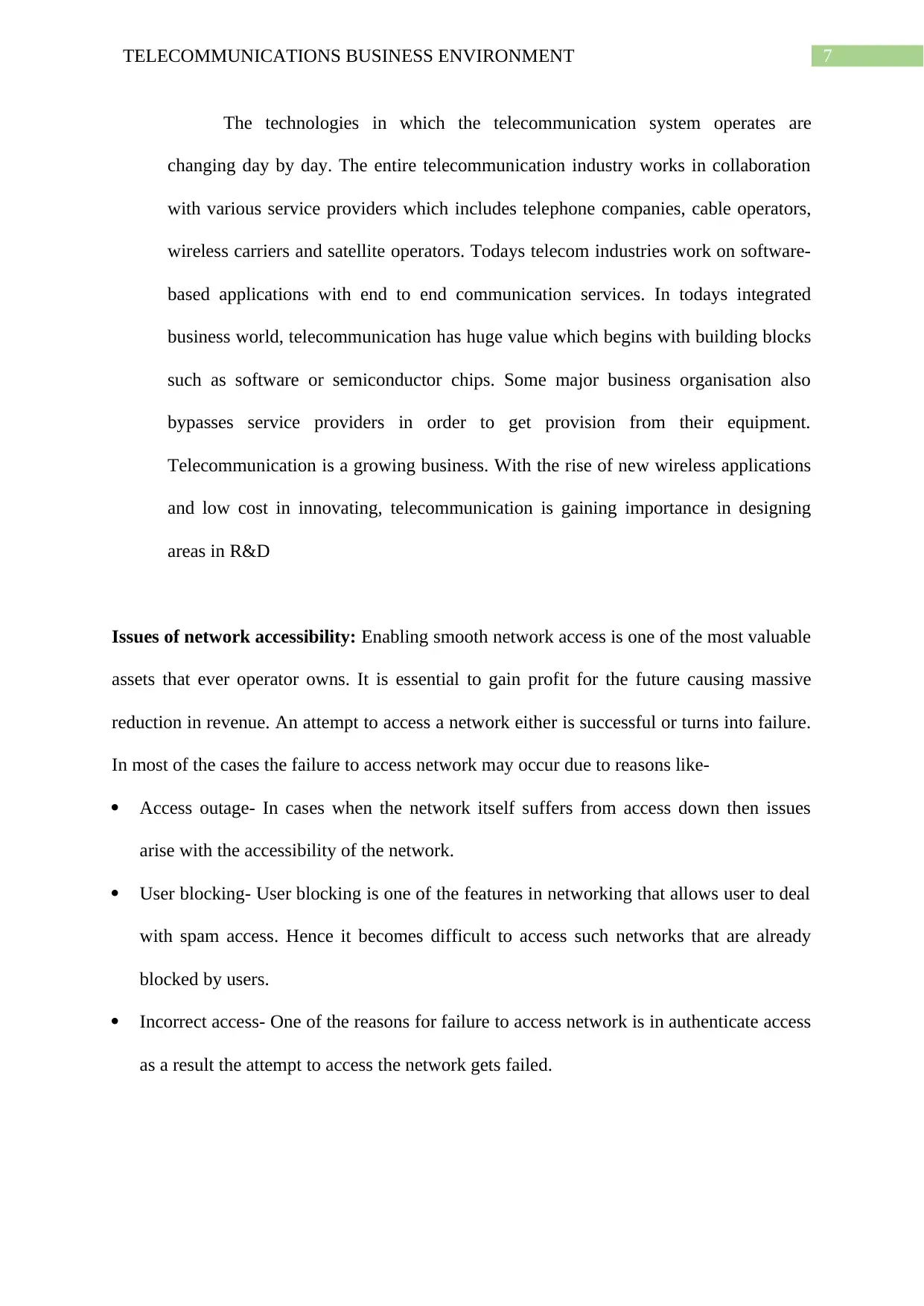
7TELECOMMUNICATIONS BUSINESS ENVIRONMENT
The technologies in which the telecommunication system operates are
changing day by day. The entire telecommunication industry works in collaboration
with various service providers which includes telephone companies, cable operators,
wireless carriers and satellite operators. Todays telecom industries work on software-
based applications with end to end communication services. In todays integrated
business world, telecommunication has huge value which begins with building blocks
such as software or semiconductor chips. Some major business organisation also
bypasses service providers in order to get provision from their equipment.
Telecommunication is a growing business. With the rise of new wireless applications
and low cost in innovating, telecommunication is gaining importance in designing
areas in R&D
Issues of network accessibility: Enabling smooth network access is one of the most valuable
assets that ever operator owns. It is essential to gain profit for the future causing massive
reduction in revenue. An attempt to access a network either is successful or turns into failure.
In most of the cases the failure to access network may occur due to reasons like-
Access outage- In cases when the network itself suffers from access down then issues
arise with the accessibility of the network.
User blocking- User blocking is one of the features in networking that allows user to deal
with spam access. Hence it becomes difficult to access such networks that are already
blocked by users.
Incorrect access- One of the reasons for failure to access network is in authenticate access
as a result the attempt to access the network gets failed.
The technologies in which the telecommunication system operates are
changing day by day. The entire telecommunication industry works in collaboration
with various service providers which includes telephone companies, cable operators,
wireless carriers and satellite operators. Todays telecom industries work on software-
based applications with end to end communication services. In todays integrated
business world, telecommunication has huge value which begins with building blocks
such as software or semiconductor chips. Some major business organisation also
bypasses service providers in order to get provision from their equipment.
Telecommunication is a growing business. With the rise of new wireless applications
and low cost in innovating, telecommunication is gaining importance in designing
areas in R&D
Issues of network accessibility: Enabling smooth network access is one of the most valuable
assets that ever operator owns. It is essential to gain profit for the future causing massive
reduction in revenue. An attempt to access a network either is successful or turns into failure.
In most of the cases the failure to access network may occur due to reasons like-
Access outage- In cases when the network itself suffers from access down then issues
arise with the accessibility of the network.
User blocking- User blocking is one of the features in networking that allows user to deal
with spam access. Hence it becomes difficult to access such networks that are already
blocked by users.
Incorrect access- One of the reasons for failure to access network is in authenticate access
as a result the attempt to access the network gets failed.
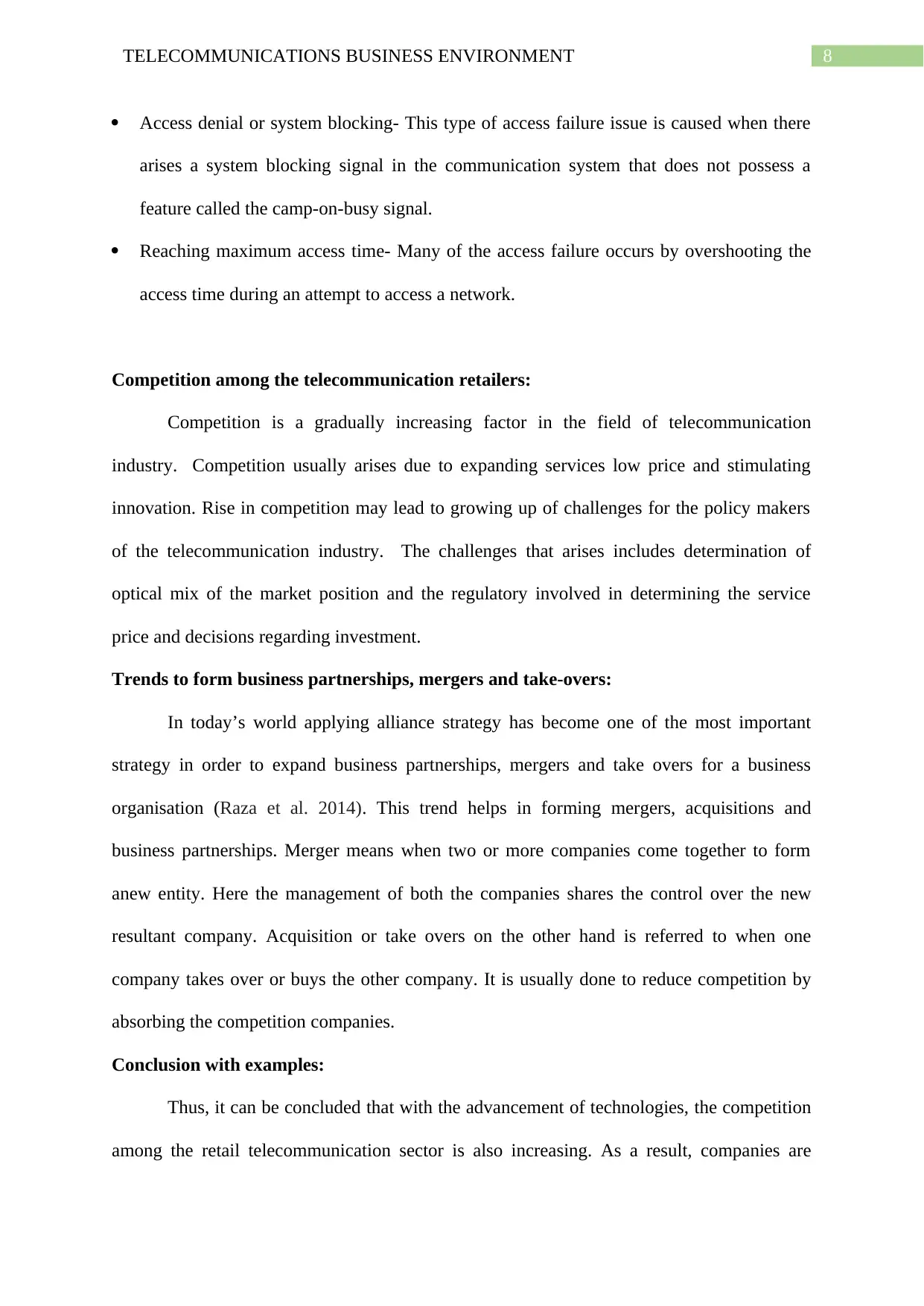
8TELECOMMUNICATIONS BUSINESS ENVIRONMENT
Access denial or system blocking- This type of access failure issue is caused when there
arises a system blocking signal in the communication system that does not possess a
feature called the camp-on-busy signal.
Reaching maximum access time- Many of the access failure occurs by overshooting the
access time during an attempt to access a network.
Competition among the telecommunication retailers:
Competition is a gradually increasing factor in the field of telecommunication
industry. Competition usually arises due to expanding services low price and stimulating
innovation. Rise in competition may lead to growing up of challenges for the policy makers
of the telecommunication industry. The challenges that arises includes determination of
optical mix of the market position and the regulatory involved in determining the service
price and decisions regarding investment.
Trends to form business partnerships, mergers and take-overs:
In today’s world applying alliance strategy has become one of the most important
strategy in order to expand business partnerships, mergers and take overs for a business
organisation (Raza et al. 2014). This trend helps in forming mergers, acquisitions and
business partnerships. Merger means when two or more companies come together to form
anew entity. Here the management of both the companies shares the control over the new
resultant company. Acquisition or take overs on the other hand is referred to when one
company takes over or buys the other company. It is usually done to reduce competition by
absorbing the competition companies.
Conclusion with examples:
Thus, it can be concluded that with the advancement of technologies, the competition
among the retail telecommunication sector is also increasing. As a result, companies are
Access denial or system blocking- This type of access failure issue is caused when there
arises a system blocking signal in the communication system that does not possess a
feature called the camp-on-busy signal.
Reaching maximum access time- Many of the access failure occurs by overshooting the
access time during an attempt to access a network.
Competition among the telecommunication retailers:
Competition is a gradually increasing factor in the field of telecommunication
industry. Competition usually arises due to expanding services low price and stimulating
innovation. Rise in competition may lead to growing up of challenges for the policy makers
of the telecommunication industry. The challenges that arises includes determination of
optical mix of the market position and the regulatory involved in determining the service
price and decisions regarding investment.
Trends to form business partnerships, mergers and take-overs:
In today’s world applying alliance strategy has become one of the most important
strategy in order to expand business partnerships, mergers and take overs for a business
organisation (Raza et al. 2014). This trend helps in forming mergers, acquisitions and
business partnerships. Merger means when two or more companies come together to form
anew entity. Here the management of both the companies shares the control over the new
resultant company. Acquisition or take overs on the other hand is referred to when one
company takes over or buys the other company. It is usually done to reduce competition by
absorbing the competition companies.
Conclusion with examples:
Thus, it can be concluded that with the advancement of technologies, the competition
among the retail telecommunication sector is also increasing. As a result, companies are
⊘ This is a preview!⊘
Do you want full access?
Subscribe today to unlock all pages.

Trusted by 1+ million students worldwide
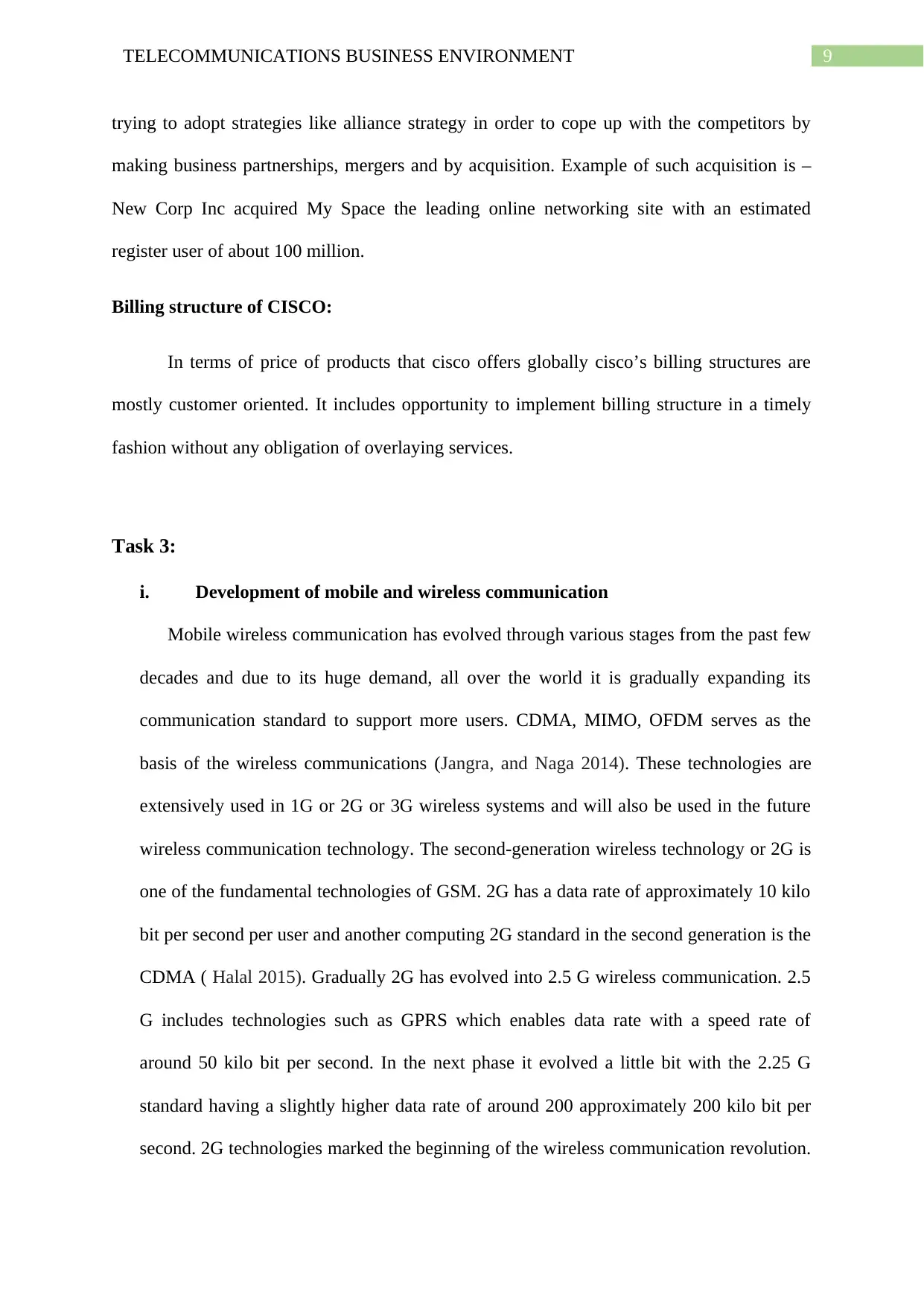
9TELECOMMUNICATIONS BUSINESS ENVIRONMENT
trying to adopt strategies like alliance strategy in order to cope up with the competitors by
making business partnerships, mergers and by acquisition. Example of such acquisition is –
New Corp Inc acquired My Space the leading online networking site with an estimated
register user of about 100 million.
Billing structure of CISCO:
In terms of price of products that cisco offers globally cisco’s billing structures are
mostly customer oriented. It includes opportunity to implement billing structure in a timely
fashion without any obligation of overlaying services.
Task 3:
i. Development of mobile and wireless communication
Mobile wireless communication has evolved through various stages from the past few
decades and due to its huge demand, all over the world it is gradually expanding its
communication standard to support more users. CDMA, MIMO, OFDM serves as the
basis of the wireless communications (Jangra, and Naga 2014). These technologies are
extensively used in 1G or 2G or 3G wireless systems and will also be used in the future
wireless communication technology. The second-generation wireless technology or 2G is
one of the fundamental technologies of GSM. 2G has a data rate of approximately 10 kilo
bit per second per user and another computing 2G standard in the second generation is the
CDMA ( Halal 2015). Gradually 2G has evolved into 2.5 G wireless communication. 2.5
G includes technologies such as GPRS which enables data rate with a speed rate of
around 50 kilo bit per second. In the next phase it evolved a little bit with the 2.25 G
standard having a slightly higher data rate of around 200 approximately 200 kilo bit per
second. 2G technologies marked the beginning of the wireless communication revolution.
trying to adopt strategies like alliance strategy in order to cope up with the competitors by
making business partnerships, mergers and by acquisition. Example of such acquisition is –
New Corp Inc acquired My Space the leading online networking site with an estimated
register user of about 100 million.
Billing structure of CISCO:
In terms of price of products that cisco offers globally cisco’s billing structures are
mostly customer oriented. It includes opportunity to implement billing structure in a timely
fashion without any obligation of overlaying services.
Task 3:
i. Development of mobile and wireless communication
Mobile wireless communication has evolved through various stages from the past few
decades and due to its huge demand, all over the world it is gradually expanding its
communication standard to support more users. CDMA, MIMO, OFDM serves as the
basis of the wireless communications (Jangra, and Naga 2014). These technologies are
extensively used in 1G or 2G or 3G wireless systems and will also be used in the future
wireless communication technology. The second-generation wireless technology or 2G is
one of the fundamental technologies of GSM. 2G has a data rate of approximately 10 kilo
bit per second per user and another computing 2G standard in the second generation is the
CDMA ( Halal 2015). Gradually 2G has evolved into 2.5 G wireless communication. 2.5
G includes technologies such as GPRS which enables data rate with a speed rate of
around 50 kilo bit per second. In the next phase it evolved a little bit with the 2.25 G
standard having a slightly higher data rate of around 200 approximately 200 kilo bit per
second. 2G technologies marked the beginning of the wireless communication revolution.
Paraphrase This Document
Need a fresh take? Get an instant paraphrase of this document with our AI Paraphraser
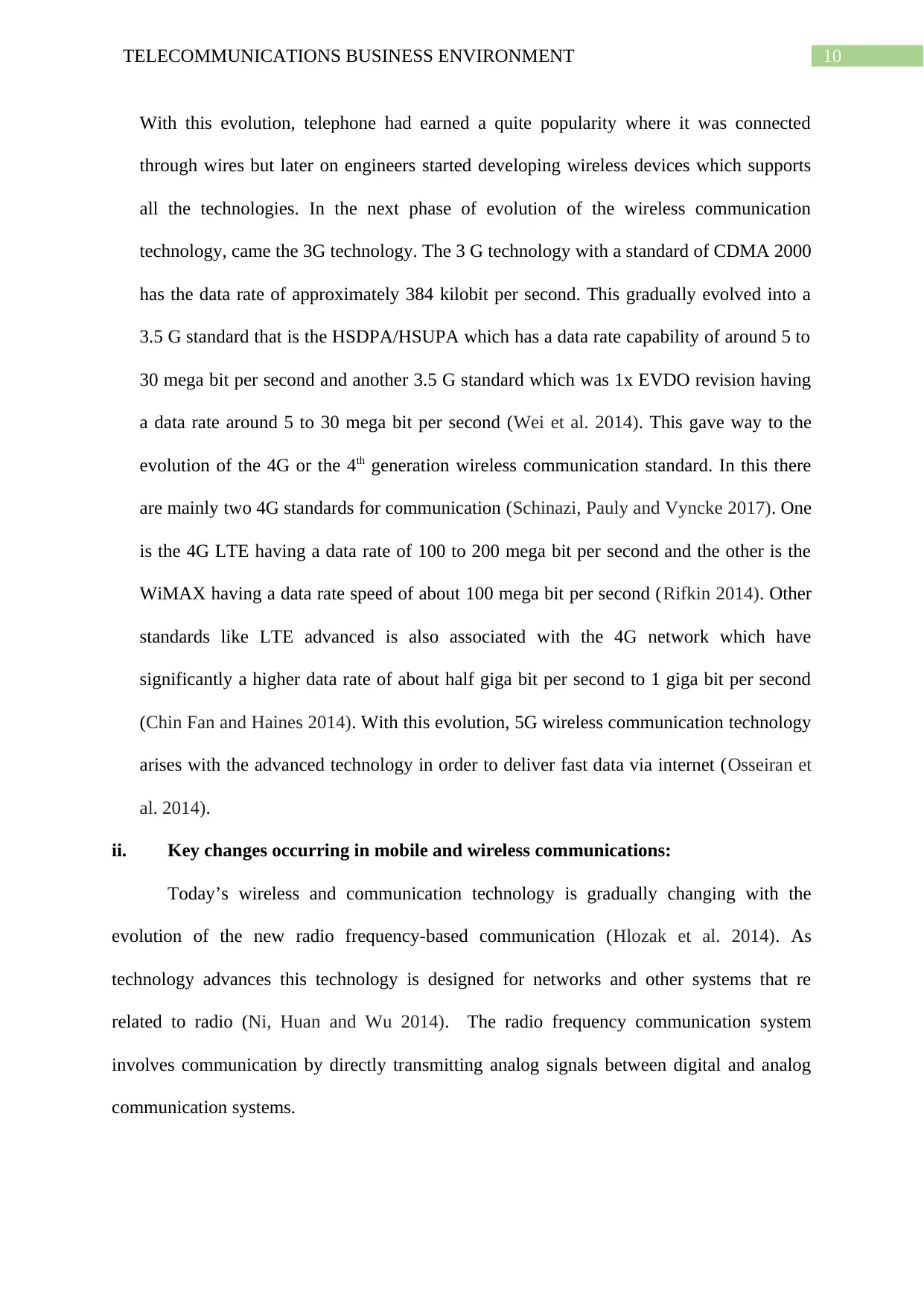
10TELECOMMUNICATIONS BUSINESS ENVIRONMENT
With this evolution, telephone had earned a quite popularity where it was connected
through wires but later on engineers started developing wireless devices which supports
all the technologies. In the next phase of evolution of the wireless communication
technology, came the 3G technology. The 3 G technology with a standard of CDMA 2000
has the data rate of approximately 384 kilobit per second. This gradually evolved into a
3.5 G standard that is the HSDPA/HSUPA which has a data rate capability of around 5 to
30 mega bit per second and another 3.5 G standard which was 1x EVDO revision having
a data rate around 5 to 30 mega bit per second (Wei et al. 2014). This gave way to the
evolution of the 4G or the 4th generation wireless communication standard. In this there
are mainly two 4G standards for communication (Schinazi, Pauly and Vyncke 2017). One
is the 4G LTE having a data rate of 100 to 200 mega bit per second and the other is the
WiMAX having a data rate speed of about 100 mega bit per second (Rifkin 2014). Other
standards like LTE advanced is also associated with the 4G network which have
significantly a higher data rate of about half giga bit per second to 1 giga bit per second
(Chin Fan and Haines 2014). With this evolution, 5G wireless communication technology
arises with the advanced technology in order to deliver fast data via internet (Osseiran et
al. 2014).
ii. Key changes occurring in mobile and wireless communications:
Today’s wireless and communication technology is gradually changing with the
evolution of the new radio frequency-based communication (Hlozak et al. 2014). As
technology advances this technology is designed for networks and other systems that re
related to radio (Ni, Huan and Wu 2014). The radio frequency communication system
involves communication by directly transmitting analog signals between digital and analog
communication systems.
With this evolution, telephone had earned a quite popularity where it was connected
through wires but later on engineers started developing wireless devices which supports
all the technologies. In the next phase of evolution of the wireless communication
technology, came the 3G technology. The 3 G technology with a standard of CDMA 2000
has the data rate of approximately 384 kilobit per second. This gradually evolved into a
3.5 G standard that is the HSDPA/HSUPA which has a data rate capability of around 5 to
30 mega bit per second and another 3.5 G standard which was 1x EVDO revision having
a data rate around 5 to 30 mega bit per second (Wei et al. 2014). This gave way to the
evolution of the 4G or the 4th generation wireless communication standard. In this there
are mainly two 4G standards for communication (Schinazi, Pauly and Vyncke 2017). One
is the 4G LTE having a data rate of 100 to 200 mega bit per second and the other is the
WiMAX having a data rate speed of about 100 mega bit per second (Rifkin 2014). Other
standards like LTE advanced is also associated with the 4G network which have
significantly a higher data rate of about half giga bit per second to 1 giga bit per second
(Chin Fan and Haines 2014). With this evolution, 5G wireless communication technology
arises with the advanced technology in order to deliver fast data via internet (Osseiran et
al. 2014).
ii. Key changes occurring in mobile and wireless communications:
Today’s wireless and communication technology is gradually changing with the
evolution of the new radio frequency-based communication (Hlozak et al. 2014). As
technology advances this technology is designed for networks and other systems that re
related to radio (Ni, Huan and Wu 2014). The radio frequency communication system
involves communication by directly transmitting analog signals between digital and analog
communication systems.
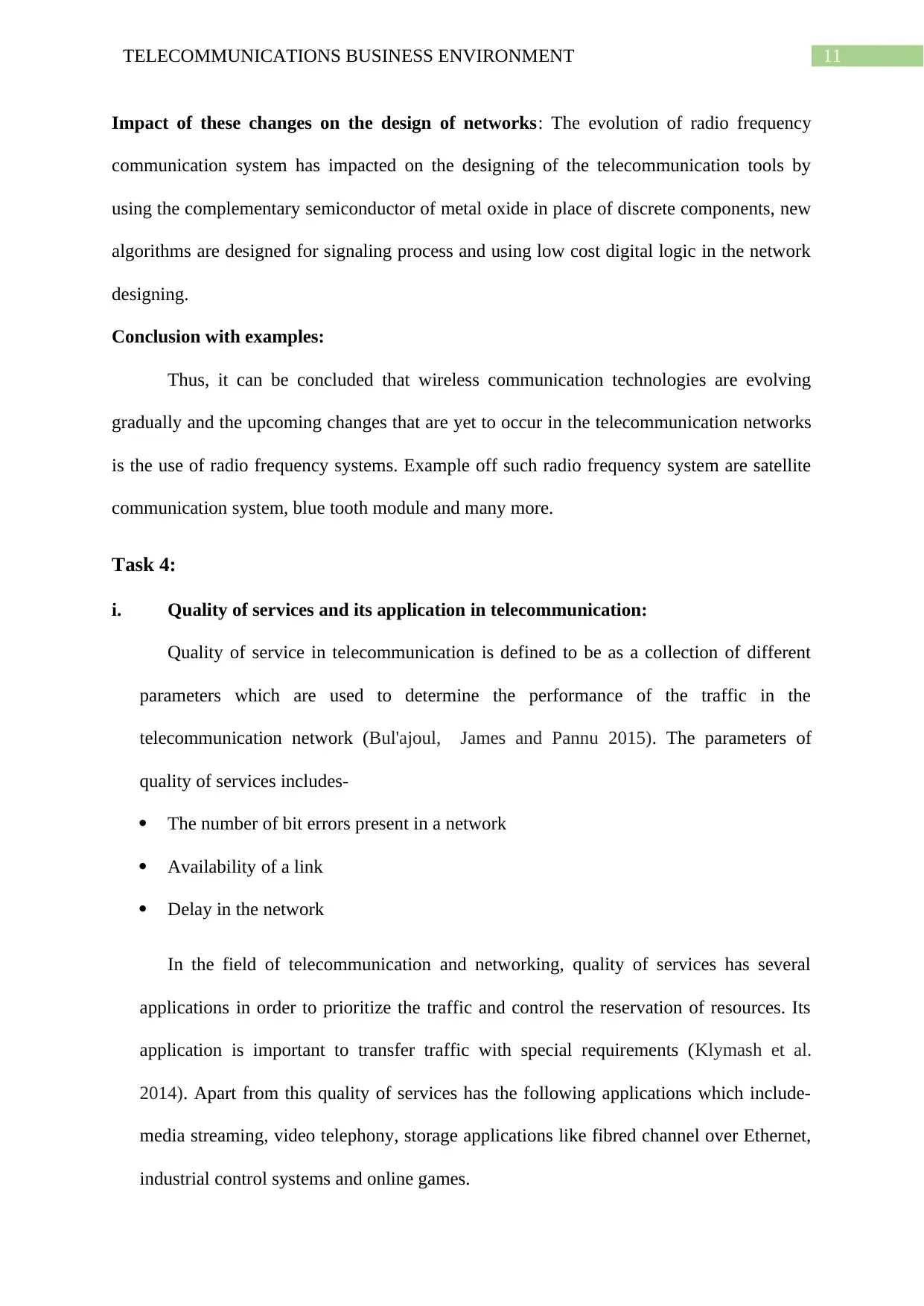
11TELECOMMUNICATIONS BUSINESS ENVIRONMENT
Impact of these changes on the design of networks: The evolution of radio frequency
communication system has impacted on the designing of the telecommunication tools by
using the complementary semiconductor of metal oxide in place of discrete components, new
algorithms are designed for signaling process and using low cost digital logic in the network
designing.
Conclusion with examples:
Thus, it can be concluded that wireless communication technologies are evolving
gradually and the upcoming changes that are yet to occur in the telecommunication networks
is the use of radio frequency systems. Example off such radio frequency system are satellite
communication system, blue tooth module and many more.
Task 4:
i. Quality of services and its application in telecommunication:
Quality of service in telecommunication is defined to be as a collection of different
parameters which are used to determine the performance of the traffic in the
telecommunication network (Bul'ajoul, James and Pannu 2015). The parameters of
quality of services includes-
The number of bit errors present in a network
Availability of a link
Delay in the network
In the field of telecommunication and networking, quality of services has several
applications in order to prioritize the traffic and control the reservation of resources. Its
application is important to transfer traffic with special requirements (Klymash et al.
2014). Apart from this quality of services has the following applications which include-
media streaming, video telephony, storage applications like fibred channel over Ethernet,
industrial control systems and online games.
Impact of these changes on the design of networks: The evolution of radio frequency
communication system has impacted on the designing of the telecommunication tools by
using the complementary semiconductor of metal oxide in place of discrete components, new
algorithms are designed for signaling process and using low cost digital logic in the network
designing.
Conclusion with examples:
Thus, it can be concluded that wireless communication technologies are evolving
gradually and the upcoming changes that are yet to occur in the telecommunication networks
is the use of radio frequency systems. Example off such radio frequency system are satellite
communication system, blue tooth module and many more.
Task 4:
i. Quality of services and its application in telecommunication:
Quality of service in telecommunication is defined to be as a collection of different
parameters which are used to determine the performance of the traffic in the
telecommunication network (Bul'ajoul, James and Pannu 2015). The parameters of
quality of services includes-
The number of bit errors present in a network
Availability of a link
Delay in the network
In the field of telecommunication and networking, quality of services has several
applications in order to prioritize the traffic and control the reservation of resources. Its
application is important to transfer traffic with special requirements (Klymash et al.
2014). Apart from this quality of services has the following applications which include-
media streaming, video telephony, storage applications like fibred channel over Ethernet,
industrial control systems and online games.
⊘ This is a preview!⊘
Do you want full access?
Subscribe today to unlock all pages.

Trusted by 1+ million students worldwide
1 out of 18
Related Documents
Your All-in-One AI-Powered Toolkit for Academic Success.
+13062052269
info@desklib.com
Available 24*7 on WhatsApp / Email
![[object Object]](/_next/static/media/star-bottom.7253800d.svg)
Unlock your academic potential
Copyright © 2020–2025 A2Z Services. All Rights Reserved. Developed and managed by ZUCOL.





